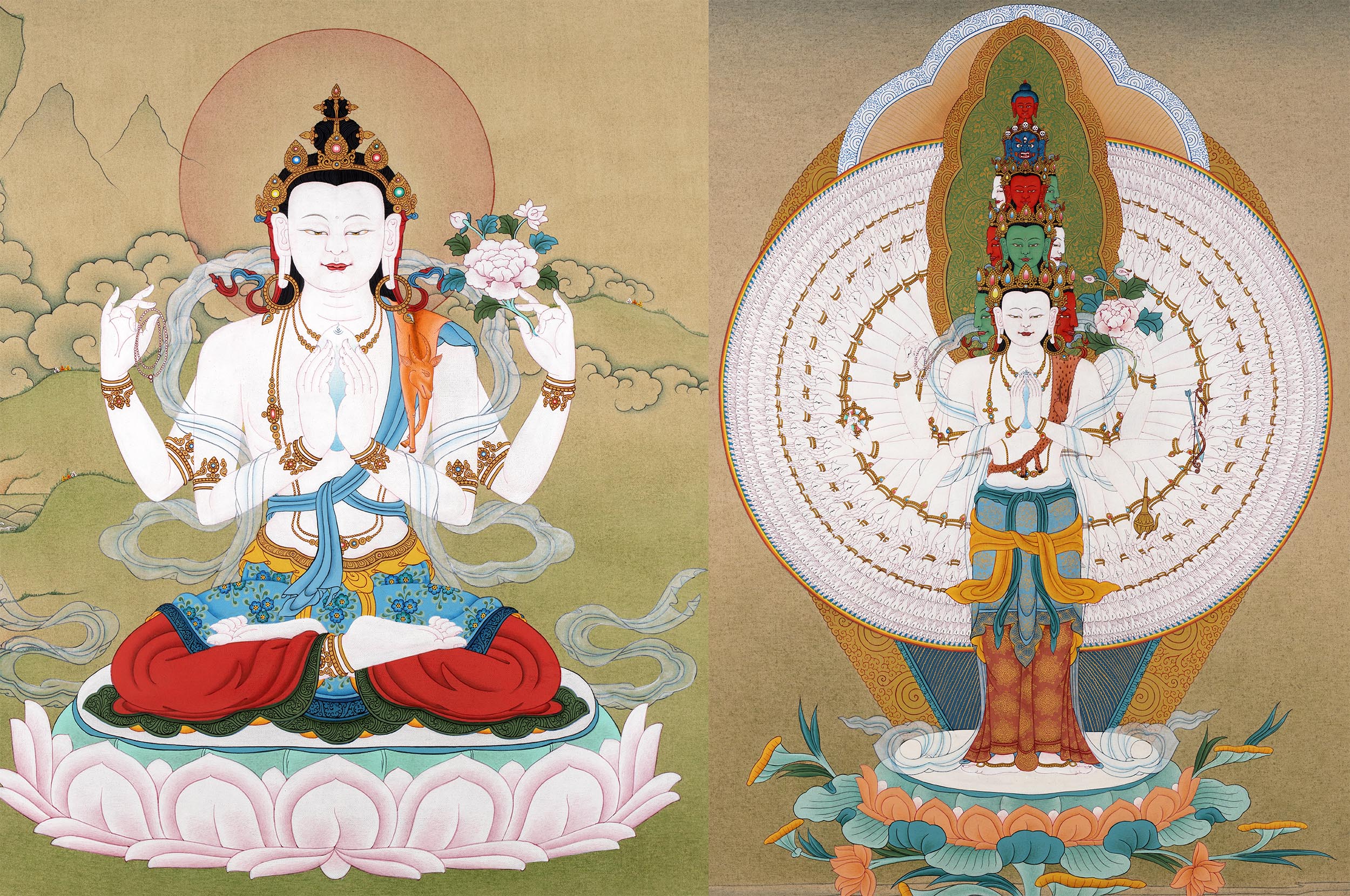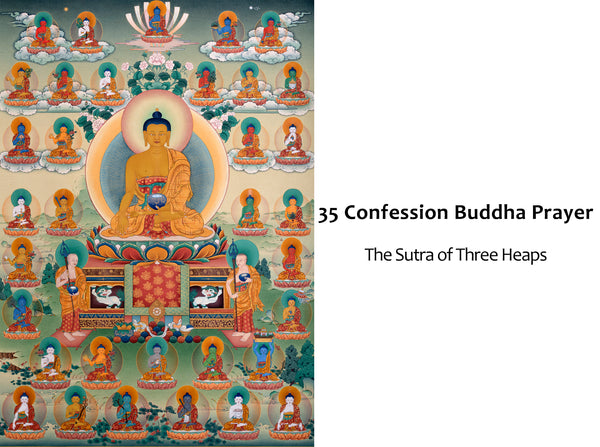Chenrezig: An introduction

A traditional commentary on the Deer Skin of Chenrezig:
Significance of the Deer skin in spiritual practice
4 armed Chenrezig:
- A Five-jeweled crown
- Earrings
- A short necklace
- A belt
- Bracelets
- Anklets
- A long necklace that reaches below the navel
- A shorter necklace that reaches to the breast

Click to view Chenrezig thangka prints
The Chenrezig Mantra:

Meaning of Om Mani Padme Hum
Through the blessings of Chenrezig and the practice of method and wisdom, we transform our body, speech, and mind. We meet the full enlightenment of the five buddha families.
The Blessings of Om Mani Padme Hum
Om Mani Padme Hung can be regarded as an unfathomable form of compassion. This powerful mantra is very much heard of in the world though few seem to chant it with full devotion and connection with the words.
According to Buddhist texts, Om Mani Padme Hung which sometimes people also write as Om Mani Peme Hung carries a myriad of meanings which ultimately totals to compassion indeed.
According to the book 'Buddhist Fasting Practice' by Wangchen Rinpoche, Om Mani Padme Hung is related to Chenrezig. Several antidotes and stories of Chenrezig, who is also called Avalokiteshvara by different religious practitioners and believers, are popular in the world. Basically, he is an embodiment of compassion.
The book says the letter Om equals to all the Buddha's body. This means the sound Om alone stands for the total essence of all the Buddhas of all the eras – past, present, and future. Whenever one pronounces the supreme word Om, it is regarded as a prayer to each and every Buddha. Additionally, one is also connecting to latent Buddha within oneself. This is just amazing. Because this reminds one of the possibilities of fanning the Buddha within and feeling liberated from the vices of the world.
Even in Hinduism, the word Om is regarded as the supreme sound. The world alone is said to carry the essence of the entire universe. Many texts describe the word as the savior no matter in which condition a person is. They say reciting Om repeatedly takes one to the light from the ignorance and makes the surrounding equally pure. Practitioners are found to chant Om alone for a number of times. Chanting Om for certain number of times is believed to affect oneself and beyond in a certain way. Hindu temples are seen adorned with Om in various forms. The glory of Om is indeed inexpressible.
Let's come to the meaning and vibration of Mani and Padme. The two sounds, according to the book, enhance the meaning of Om and vice versa. The text says that Mani and Padme actually make Om that powerful within this mantra. While Mani means jewels Padme stands for lotus.
Bodhichitta is a quite popular word among spiritual seekers. This jewel represented by Mani in this mantra is the same bodhichitta, which means the enlightened heart. It is said that it requires an enlightened heart to respond to people's inner calling or wishes. Just like the outer wishes are fulfilled by different kinds of ornaments, Bodhichitta is said to reach a person's soul and help transform it. It is regarded as the lord of compassion, the lord Chenrezig.
Similarly, the lotus signifies wisdom. The worldly creatures are always entangled in different affairs. Due to ignorance, they are restless. However, it does not occur to all to look for help in such a situation. But when one humbly asks for a clearer path, the divine beings come for help including the lord Chenrezig.
According to various Buddhist texts, the will to realize the higher self leads one to the path of spirituality plotting the 'meetings' with the enlightened beings. The mantra Om Mani Padme Hum, even if someone recites without fully comprehending it, is believed to attract similar spiritual vibes making it possible for them to reach the source of knowledge and enlightenment.
Lotus, which grows and blooms in muddy water, depicts the same reality. Just like a lotus remains in a dirty place and yet looks detached from it, humans are capable of being pure at heart despite being involved in worldly activities. Buddhist and Hindu texts thus place a great value on a lotus.
When one recites the mantra, Om Mani Padme Hung, it is suggested to internalize the nature of the lotus and save oneself from worldly stresses and miseries.
The last letter Hum is equally important. Hum holds the qualities of immutabilities and unity. Immutability is the quality of vajra. And this vajra quality of mind demonstrates the union of compassion and emptiness, which is Chenrezig's nature of mind. It further says that the immutable quality of his mind remains so stable that it endlessly takes care of sentient beings. Because a wavering mind cannot help others even if it tries to, the quality of stability or unwavering force is quite remarkable here.
"Practically speaking, when we recite the mantra OM MANI PADME HUM we are showing our faith and devotion to Chenrezig and the buddhas, taking refuge in them, seeking protection for all sentient beings, engendering bodhichitta, purifying negativities, shutting the door to the six realms and so forth"
The six syllabled mantra is so popular that it is recited in dozens of languages of different countries. Nepali, Assamese, Malyayalam, Roman, Sanskrit, Bengali, and many other communities are quite fond of the mantra.
In Tibetan Buddhism, it is regarded as the most important mantra. It is practiced uniformly by ordinary people to great Buddhist masters. Monasteries and temples are seen reflecting in one or the other way. It is believed that the first known description of the mantra appeared in Karandavyuhastutra. This ancient sutra has claimed it to be the most beneficial mantra for all spiritual seekers. Om Mani Padme Hum can lead one to bliss as well as liberation, according to both the ancient and the modern Buddhist texts.
Karandavyuhasutra says the mantra is the base or the pith of 'eighty-four thousand dharmas and chanting it repeatedly showers an equal amount of blessings on the one. Because it has to do with the inner heart of the practitioner, the mantra changes one rather swiftly than expected. Many spiritual texts have always claimed that the most difficult thing for a person to do is to change the heart or feel the purity within. Hence, the mantra is considered very precious for the human world. The sutra suggests following certain disciplines while chanting the mantra in order to get highly benefitted. Om Mani Padme Hum, on the other hand, even if is overheard is said to leave a great positive effect on the listeners.



5 comments
Susana
Feliz de haber encontrado esta explicacion del mantra que recito varias veces por dia pero no sabia exactamente lo poderoso que es. Gracias!!!!!
Denise
I’m grateful to have found this explanation; it helps to better understand the mantra and the interconnection between all sentient beings and phenomena. Om mani padme hum
Robyn
Comforting to have benefits of om mani explained instead of reciting sans understanding. Thank you.🪷
Martin
Thank you! Very much appreciated text to read! Om mani padme hum
alunada
namaste.